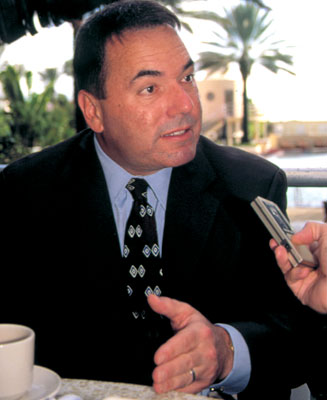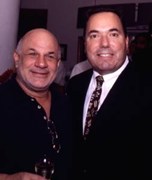
Long before he became mayor of the City of Miami Beach in 1997, Neisen Kasdin had a hand in its transformation from run-down tropical rest home to red-hot international resort destination. Born on the Beach to parents who also played significant roles in the history of Miami Beach, Kasdin began his public service career in 1980 when, fresh out of the University of Florida Law School, he joined the historic preservation movement that would become the salvation of the Art Deco architectural treasure that is South Beach.
“I always believed there would be a renaissance,” says Kasdin, who got elected to the city commission in 1991 and won the mayor’s seat in 1997. He was re-elected in 1999. Throughout the 1980’s, he worked in the historic preservation movement and chaired a campaign to approve a bond issue to revitalize boarded-up and largely abandoned Ocean Drive. “Even then,” he says, “I was very bullish on South Beach. But I don’t think anyone in the early years thought it would grow to the extent it has grown to. We realized we had something special. We just didn’t realize how special it was.”
Kasdin notes that the city fathers of that era, along with aggressive real estate developers, wanted to bulldoze the dilapidated Art Deco buildings and build a new, glistening resort. “A new, glistening and failed resort,” Kasdin says with a laugh over coffee at the Raleigh Hotel, whose renovation in 1990 was another critical moment in the long South Beach renaissance. “You had to be there to understand how out of touch the civic and business and political leadership of the community was at that time. When you mentioned preservation, they said, ‘What are you talking about?’ They didn’t know about Art deco and they didn’t see its potential. They thought we were nuts.”

Instead of preserving and restoring South Beach’s unique architectural heritage, the developers and their political allies wanted to erect high-rise towers, bring in casino gambling and open fabled pedestrian mall Lincoln Road to vehicular traffic. Today, of course, it is hard to believe anyone could have been so misguided. Back then, however, the threat of the bulldozer was a daily menace to Kasdin and his fellow preservationists.
“Except for the fact that there was a depressed real estate market in the early ’80’s and we also had a vigorous preservation advocacy movement,” Kasdin says today, “these wonderful buildings wouldn’t be sitting here and we wouldn’t be sitting here either.”
In the mid-1980’s, Kasdin explains, the fashion-photo industry discovered South Beach for its magical winter light and warm climate. A seasonal population of models followed, and then Europeans drawn by the emerging Bohemian trendiness. “The rest is history,” Kasdin says with a proud smile.
Today, Kasdin points out, Miami Beach is much more than just another hot tourist destination. A big part of the reason why it attracts eight million visitors a year — 80% of the tourists who come to Miami-Dade County — is that it is more than a palm-lined beach resort. It is also a world-class cultural arts center and a hub for media, entertainment and Internet companies. “One of my biggest surprises,” Kasdin says, “has been the development of Miami Beach as a business and media center. We have television companies, record labels, Internet ventures. We’ve become the media hub of the Americas.”
Kasdin says he believes one important reason why companies are setting up shop in Miami Beach is because of its high quality of life — a small residential community with historic neighborhoods and a culturally diverse population brought together in the two realms that truly define Miami Beach — the cultural arts and world-renowned nightlife.
“The nightlife industry has always been part of the character of Miami Beach,” says Kasdin, who literally grew up in the club business. His father, who came to Miami Beach in 1939 from West Virginia by way of New York, owned South Florida’s largest drug store chain and had interests in three nightclubs including Club Mocambo and Ciro’s. His mother, who arrived in 1944, worked for the father of TV news icon Barbara Walters booking acts into the legendary Latin Quarter.
Given his family history, Kasdin, who has been married for 18 years and has two teenaged sons, takes issue with those who say he and the city administration are anti-nightlife. In fact, the mayor says, he strongly supports a vibrant, upscale nightlife industry. “But I think you have some spin-masters who are trying to say the city is anti-nightlife because in the vicissitudes of the club business, these places go up and down. If they’re not doing well, they like to blame the city and say it’s anti-nightlife.”
By the same token, not every citizen agrees with the preferential treatment the city gives the cultural arts, including organizations such as Miami City Ballet and New World Symphony. Yet Kasdin says he is passionately committed to the cultural arts as a foundational element in the Miami Beach lifestyle. In that spirit, he helped launch the publicly-funded Miami Beach Cultural Arts Council two years ago. “We’re one of the few cities in this country that has not only a Cultural Arts Council, but an endowment for the arts. We spend a lot of money on the arts in this city and it is well worth it for the benefits we receive.”
Among the few things that truly frustrate Kasdin, he says, are chronic traffic and parking problems and what he and others see as a business-unfriendly city bureaucracy.
But to a certain extent, he admits, residents and visitors must accept that such realities are part of big-time success as a world destination. “We are going to have to adjust to the lifestyle of a busy urban center,” Kasdin says. “We are not going to have empty streets and free-flowing traffic. In the long run, people are going to have to get used to things like walking or Rollerblading, which they are already doing.”
By the same token, he says, business owners must understand that although the city administration is working hard to streamline the process for things such as building permits, the sheer volume of new development in Miami Beach is overwhelming.
To help resolve parking and traffic problems, Kasdin has proposed to Miami-Dade County a trolley system for carrying people back and forth across Biscayne Bay.
When asked about his legacy, Kasdin, who has not decided whether to run for a third term as mayor next November, says: “The city is headed in the right direction. We have a strong respect for our historic architecture. We’ve become a wonderful cultural arts community. We’ve become a world-class media center. We are a place that cherishes diversity instead of just tolerating it. Everyone in this city feels comfortable, regardless of their background. The growth and evolution of Miami Beach have been something I’ve been able to participate in. The overall evolution of the city is the thing I’m proudest of, because I had a hand in it for 20 years.”
